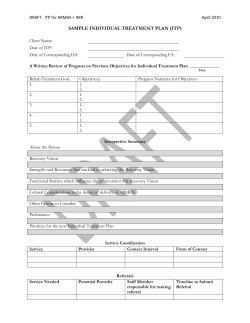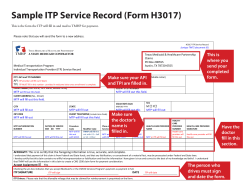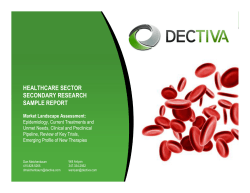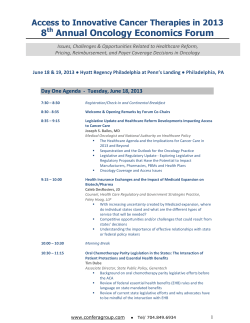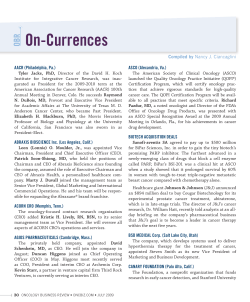
University of Michigan Pediatric Heme/Onc Program Clinical Practice Guidelines
University of Michigan Pediatric Heme/Onc Program Clinical Practice Guidelines EVALUATION, DIAGNOSIS & MANAGEMENT OF IMMUNE THROMBOCYTOPENIA Origin Date: April 2010 Revision Date: March 2011 Date of Next Revision: March 2012 I. OVERVIEW: *The following definitions of acute, persistent and chronic as well as primary and secondary ITP were recently formulated and adopted by the International Working Group on ITP1.* Immune thrombocytopenia (ITP) is an acquired generally benign disorder in which antibodies are generated against platelet antigens resulting in accelerated platelet destruction and a platelet count less than 100,000/mm3. In children ITP is most frequently an acute, self-resolving condition; however, a minority of patients will develop either persistent ITP, defined as thrombocytopenia lasting longer than 3 months but resolving by 12 months, or chronic ITP, defined as thrombocytopenia lasting longer than 12 months, and will require ongoing care. II. PURPOSE: Pediatric patients suspected of having new-onset ITP require an evaluation to rule out other diagnoses and to initiate treatment as necessary to minimize bleeding risks. These guidelines are intended to utilize available evidence-based data and expert opinion to facilitate safe and efficient evaluation/management of patients with suspected new-onset ITP as well as continued management of patients with persistent or chronic ITP. III. SCOPE: This document is intended to provide evidence-based guidelines for the initial care of pediatric patients presenting with concern for newly diagnosed immune thrombocytopenia. Additionally, management of patients with persistent or chronic ITP requiring additional treatment is briefly covered. IV. NEW REFERRALS: A. Any patient referred to our department (via page, M-Line call or faxed outpatient referral) should be triaged through the on-call PHO fellow (when available) and discussed with the on-service pediatric hematology/oncology attending. Patients with a new presentation concerning for ITP but with an incomplete work up will generally require evaluation in the UM ED. Direct admissions may be arranged at the discretion of the on-service PHO attending for asymptomatic patients who MUST have been seen by a physician and had labs drawn on the day of referral. For full details regarding the direct admission criteria, please refer to the Mott direct admit policy found at the web address: http://www.med.umich.edu/i/policies/pediatric/pdfs/admissions.pdf. Chapter 1.2 1 Effective April 2011 The goal of these guidelines is to assist in the care of patients in coordination with referring physicians, hematology/oncology physicians, and other caregivers. These guidelines do not replace the expertise and clinical judgment of the treating physician. Each patient’s situation must be evaluated individually. These guidelines are updated annually. To ensure that you have the most up-to-date version of the guidelines, contact the University of Michigan Pediatric Hematology/Oncology Program. Copyright 2011 by the Regents of the University of Michigan. All Rights Reserved. University of Michigan Pediatric Heme/Onc Program Clinical Practice Guidelines B. On rare occasions, new patients may be referred to the outpatient clinic and infusion center on the same day as initial contact or the following morning at the discretion of the on-call PHO attending. This practice should be considered for patients who are asymptomatic without bleeding, have a platelet count > 30,000/mm3 and are unlikely to require treatment with Rh0 (D) Immunoglobulin (WinRho) or IVIG. If a patient is to be referred to the outpatient clinic, this visit should be discussed/cleared with the attending physician overseeing clinic that day or seen by the inpatient service attending (with fellow, when available) in the outpatient clinic. V. INITIAL EVALUATION: Primary ITP remains a clinical diagnosis based on the acute onset of isolated thrombocytopenia, with a platelet count less than 100,000/mm3, frequently concurrent with the sudden onset of bruising, petechiae and/or mucous membrane bleeding in an otherwise healthy child in the absence of alternative causes of thrombocytopenia such as immunodeficiency, infection, medication exposure, bone marrow failure syndromes, malignancies and genetic thrombocytopenia syndromes. Secondary ITP includes all forms of immune-mediated thrombocytopenia except for primary ITP, e.g thrombocytopenia due to SLE or medication exposures. The classical presentation of a pediatric patient with ITP is a child between the ages of 210 years presenting with an acute onset of bruising/petechiae and a platelet count < 20,000 with a history of an antecedent viral infection. . A. History and Physical: The clinical manifestations of ITP are directly related to thrombocytopenia. Important items to query on history of presenting illness: - Onset of bleeding symptoms (bruising, gum bleeding, petechiae, nosebleeds, heavy menses, hematuria, etc.). - Presence of an antecedent viral infection. - Any associated symptoms concerning for other diagnoses, e.g. lymphadenopathy, weight loss, fatigue, rash, joint swelling, headache, etc. - Personal history of autoimmune disease. - Any previous blood counts drawn (especially helpful with platelet counts in the 50-100k range to raise concern for platelet defect or vWD). - Any recent immunizations in the past 8 weeks, specifically MMR, varicella or other live-attenuated vaccines (e.g. influenza). Chapter 1.2 2 Effective April 2011 The goal of these guidelines is to assist in the care of patients in coordination with referring physicians, hematology/oncology physicians, and other caregivers. These guidelines do not replace the expertise and clinical judgment of the treating physician. Each patient’s situation must be evaluated individually. These guidelines are updated annually. To ensure that you have the most up-to-date version of the guidelines, contact the University of Michigan Pediatric Hematology/Oncology Program. Copyright 2011 by the Regents of the University of Michigan. All Rights Reserved. University of Michigan Pediatric Heme/Onc Program Clinical Practice Guidelines Family History: - Family members with known bleeding disorders (hemophilia, von Willebrands disease, platelet function defects, Wiskott-Aldrich). - Family members with known immunodeficiencies or bone marrow failure syndromes. - Family members with known autoimmune disease. Physical Exam: - Inspect oral cavity for muscosal bleeding, i.e. wet purpura, gum bleeding and for palatal petechiae or gingival hyperplasia. - Assess lymph node chains for lymphadenopathy as well as abdomen for hepatosplenomegaly. - Evaluate skin for bruising and petechiae. - Make sure mental status is appropriate and there is no concern for an intracranial bleed. - Testicular examination on males in case thrombocytopenia is presenting symptom of acute leukemia B. Laboratory Evaluation: To be drawn in the ED or upon arrival at inpatient unit/outpatient clinic. The following labs should be obtained as part of the initial diagnostic ITP evaluation in ALL patients. 1. CBCPD 2. Peripheral blood smear 3. Quantitative immunoglobins (IgG, IgA, IgM) 4. Urinanalysis 5 DAT (if patient presents with concurrent anémia) A bone marrow aspirate/biopsy should also be considered initially for patients if there is concern for a clinical pathologic process other than ITP or the upfront use of steroids is anticipated that may mask a pre-leukemic process. The following labs should be obtained for patients with known ITP who may require additional treatment. 1. CBCPD 2. Blood type (if not previously known and Rh0 (D) Immunoglobulin (WinRho) administration is anticipated). Chapter 1.2 3 Effective April 2011 The goal of these guidelines is to assist in the care of patients in coordination with referring physicians, hematology/oncology physicians, and other caregivers. These guidelines do not replace the expertise and clinical judgment of the treating physician. Each patient’s situation must be evaluated individually. These guidelines are updated annually. To ensure that you have the most up-to-date version of the guidelines, contact the University of Michigan Pediatric Hematology/Oncology Program. Copyright 2011 by the Regents of the University of Michigan. All Rights Reserved. University of Michigan Pediatric Heme/Onc Program Clinical Practice Guidelines In addition, the following labs should be considered for ITP diagnoses with non-classical features or persistent/chronic ITP as clinically relevant. 1. LDH, uric acid and comprehensive metabolic panel to assist with screening for leukemia. 2. ANA to screen for SLE and other autoimmune/collagen vascular disorders. This may be of particular value in adolescent girls with a personal or family history of autoimmune disease. Patients who have a positive ANA should be referred to Pediatric Rheumatology and have additional labs of ENAB5, dsDNA antibody, C3, C4, CH50, urinanalysis, ESR and a COMP sent. 3. Pneumococcal titers, isohemagluttin titers, CH50 to evaluate for immunodeficiencies such as CVID, Wiskott-Aldrich and complement deficiencies. 4. Bone marrow aspiration and biopsy with flow cytometry and cytogenetics for myelodysplastic syndrome and bone marrow failure syndromes. 5. Viral studies for HIV, hepatitis C, EBV, parvovirus, HHV-6 and HHV-8. 6. Stool antigen test or urea breath test for H. pylori. In countries with a high prevalence of H. pylori infection, eradication of H. pylori with antibiotics and a PPI has proven fruitful in increasing platelet counts in as many as 20-50% of patients. More follow up data is needed; however, patients from Japan (or other countries where H. pylori infection is endemic) may be considered for H. pylori testing/treatment. VI. CRITERIA FOR TREATMENT A. Consider treatment for platelet level < 30,000 /mm,3 particularly for infants/toddlers who may be at increased risk of incidental head trauma2. Suggest treatment for platelet counts < 10,000/ mm3. B. Active bleeding (intracranial hemorrhage, hematuria, epistaxis, mucosal bleeding, heavy menses) with any platelet count. *Note: Of the small fraction of patients who develop intracranial hemorrhage, many of them also have concurrent hematuria as compared to patients who did not develop intracranial hemorrhage. C. High risk of fall, collision or other trauma. VII. INITIAL MANAGEMENT A. Patients with ITP and life threatening bleeding. Although ICH is rare occurring in less than 1% of patients with ITP, the consequences of ICH are severe with a 25% mortality rate and another 25% of patients suffering permanent neurologic sequelae2. It is estimated that of children who develop ICH, ~25% have ICH as their presenting symptom of ITP, with the highest risk in patients less than 3 years old with platelet counts less than 20x 10 9/L and with antecedent head Chapter 1.2 4 Effective April 2011 The goal of these guidelines is to assist in the care of patients in coordination with referring physicians, hematology/oncology physicians, and other caregivers. These guidelines do not replace the expertise and clinical judgment of the treating physician. Each patient’s situation must be evaluated individually. These guidelines are updated annually. To ensure that you have the most up-to-date version of the guidelines, contact the University of Michigan Pediatric Hematology/Oncology Program. Copyright 2011 by the Regents of the University of Michigan. All Rights Reserved. University of Michigan Pediatric Heme/Onc Program Clinical Practice Guidelines trauma2. However, ICH can occur at anytime, even with chronic ITP and in the absence of head trauma. ITP with ICH and other life threatening bleeding should be treated aggressively3: 1. Platelet transfusion 15mL/kg i) Refer to Transfusion CPG. Larger and more frequent platelet transfusions than normal may be needed to achieve/sustain a reasonable platelet count. 2. Methylprednisolone 30mg/kg (max 1gram) IV given over 20 minutes i) May repeat daily for up to 3 doses as clinically indicated. 3. IVIG 1g/kg x1 i) If platelet count remains below 20,000/ mm3 24 hours after treatment, can consider repeating 0.8g/kg dose x1 daily for up to 5 doses. ii) Refer to IVIG CPG for concerns regarding common reactions and other management. Routine IVIG premedications include: a. Acetaminophen (Tylenol) 650 mg (Pediatrics: 10-15 mg/kg/dose) PO x 1 prior to IVIG, then q6 hours prn b. Diphenhydramine (Benadryl) 25-50 mg (Pediatrics: 1 mg/kg/dose) PO/IV x 1 prior to IVIG, then q6 hours prn Depending on specific clinical circumstances, emergent splenectomy and/or the use of hemostatic agents, e.g. recombinant factor VIIa4 may need to be considered. B. ITP without life threatening bleeding Both IVIG and Rh0 (D) Immunoglobulin (WinRho) have equal efficacy in improving platelet counts of patients with ITP5. However, Rh0 (D) Immunoglobulin (WinRho) has been associated with a higher rate of adverse side effects and clinically significant hemolysis5,6. Thus, IVIG is the preferred agent when available and feasible. 1. IVIG 0.8g/kg x17 i) Most commonly will require hospitalization for IVIG administration given length of infusion, although may be administered in the outpatient infusion area if logistically feasible. ii) If platelet count remains below 20,000/ mm3 24 hours after treatment, can consider repeating 0.8g/kg dose x1. iii) Refer to IVIG CPG for concerns regarding common reactions and other management. Routine IVIG premedications include: a. Acetaminophen (Tylenol) 650 mg (Pediatrics: 10-15 mg/kg/dose) PO x 1 prior to IVIG, then q6 hours prn b. Diphenhydramine (Benadryl) 25-50 mg (Pediatrics: 1 mg/kg/dose) PO/IV x 1 prior to IVIG, then q6 hours prn Chapter 1.2 5 Effective April 2011 The goal of these guidelines is to assist in the care of patients in coordination with referring physicians, hematology/oncology physicians, and other caregivers. These guidelines do not replace the expertise and clinical judgment of the treating physician. Each patient’s situation must be evaluated individually. These guidelines are updated annually. To ensure that you have the most up-to-date version of the guidelines, contact the University of Michigan Pediatric Hematology/Oncology Program. Copyright 2011 by the Regents of the University of Michigan. All Rights Reserved. University of Michigan Pediatric Heme/Onc Program Clinical Practice Guidelines 2. Rh0 (D) Immunoglobulin (WinRho) 75mcg/kg x18 i) Contraindicated for patients with hemoglobin < 7 G/dL. Frequently causes a 1-2 gram drop in hemoglobin. ii) Will require an observation of period of at least 8 hours either in the infusion center, ED or as a short stay hospital admission. iii) To assist with hydration and minimize risk of renal dysfunction from hemolysis, a 20mL/kg 0.9NS bolus should be given concurrently with administration of the Rh0 (D) Immunoglobulin (WinRho). Maintenance IVFs during the remainder of the observation period should also be considered. iv) Urinalysis to check for hemolysis should be obtained at admission as well as 2, 4 and 8 hours post- Rh0 (D) Immunoglobulin (WinRho) administration. (Black box warning, 2010). 3. If compelling clinical reason to avoid IVIG or Rh 0 (D) Immunoglobulin (WinRho), steroids are also an option for newly diagnosed ITP 7,9,20,21. i) Prednisone: 4 mg/kg/day divided TID on days 1-7; 2 mg/kg/day divided TID on days 8-12; 1 mg/kg/day divided TID on days 13-17. Taper and discontinue by day 21. Consider starting an H2-receptor antagonist for GI protection while on Prednisone. VIII. FOLLOW-UP LABORATORY MONITORING A. Re-check CBC 24 hours after treatment i) If platelets > 20,000/ mm3 space to 7 days or as clinically indicated ii) If platelets remain below 20,000/ mm3, consider re-treatment per section VI. B. Consider additional urinalysis, LDH, bilirubin, etc for assessment of hemolysis as clinically indicated for patients who received Rh0 (D) Immunoglobulin (WinRho). IX. PLATELET TRANSFUSION A. Only indicated for life threatening active bleeding. B. Refer to Transfusion CPG. X. DISCHARGE CRITERIA/REQUIRED FOLLOW UP FOR NEWLY DIAGNOSED ITP Patients should be considered eligible for discharge to home once their observation period is complete and the following criteria are met: Chapter 1.2 6 Effective April 2011 The goal of these guidelines is to assist in the care of patients in coordination with referring physicians, hematology/oncology physicians, and other caregivers. These guidelines do not replace the expertise and clinical judgment of the treating physician. Each patient’s situation must be evaluated individually. These guidelines are updated annually. To ensure that you have the most up-to-date version of the guidelines, contact the University of Michigan Pediatric Hematology/Oncology Program. Copyright 2011 by the Regents of the University of Michigan. All Rights Reserved. University of Michigan Pediatric Heme/Onc Program Clinical Practice Guidelines 1. No active bleeding. Remember to counsel patients who have received Rh 0 (D) Immunoglobulin (WinRho) to maintain adequate hydration and to be vigilant for signs/symptoms of hemolysis. 2. No social or age-related risk of significant head injury. Consider protective helmets for toddlers and at-risk patients with developmental delay. Remember to counsel patients as necessary to avoid contact sports and other high-risk activities, e.g. diving, jumping from heights, etc., while thrombocytopenic. 3. Improving or stabilized platelet count greater than 5,000 /mm 3 and ideally greater than 10,000 /mm3. Patients should be evaluated in the outpatient Pediatric Hematology/Oncology clinic within 1-2 weeks of discharge. XI. COUNSELING REGARDING MMR VACCINATION AND ITP22 A. Incidence: MMR-associated thrombocytopenia occurs in 0.087-4/100,000 patients. ITP occurs from naturally acquired measles/rubella at in incidence of 6-1200/100,000 patients as documented from several measles/rubella outbreaks. B. Clinical Course/Outcome: MMR-associated thrombocytopenia resolves within 6 months of diagnosis in 90-95.8% of patients (as opposed to the ~75% of non-vaccineassociated ITP cases) and often has a more benign clinical course than non-vaccineassociated ITP. C. MMR Vaccination: The decision to administer the MMR vaccine to children with a history of ITP should be based on assessment of immunity after the first dose of MMR and the benefits of protection against all three viruses in the vaccine compared to the risks of recurrence of thrombocytopenia after immunization. 1. Children who develop ITP within 6 weeks of the first MMR dose should have antibody tests performed. If the child is immune, repeat immunization is not necessary. If the child is not immune (5-10% of children), a second dose of MMR should be given. 2. Children with ITP who have not received the MMR vaccine or have no evidence of immunity despite prior immunization should be immunization at the standard recommended ages unless IVIG has been given in the past 9 months. 3. Children who have had MMR-vaccine related thrombocytopenia after the first dose of MMR and were found to be non-immune, did not have a recurrence of thrombocytopenia after receiving the second dose of the MMR vaccine. *Because of the much higher likelihood of thrombocytopenia after natural infection, the benefits of vaccination greatly exceed the risk of severe thrombocytopenia caused by the vaccination.* Chapter 1.2 7 Effective April 2011 The goal of these guidelines is to assist in the care of patients in coordination with referring physicians, hematology/oncology physicians, and other caregivers. These guidelines do not replace the expertise and clinical judgment of the treating physician. Each patient’s situation must be evaluated individually. These guidelines are updated annually. To ensure that you have the most up-to-date version of the guidelines, contact the University of Michigan Pediatric Hematology/Oncology Program. Copyright 2011 by the Regents of the University of Michigan. All Rights Reserved. University of Michigan Pediatric Heme/Onc Program Clinical Practice Guidelines XII. ONGOING MANAGEMENT OF NEWLY DIAGNOSED ITP Despite an initial platelet rise in response to treatment on diagnosis, many patients will require repeat doses of either IVIG or Rh0 (D) Immunoglobulin (WinRho) within a few weeks/months. Patients who have a recurrence of clinical signs or symptoms (petechiae, bruising, epistaxis, menorrhagia, wet purpura, hematuria) of bleeding and or platelet counts < 10,000 /mm3, should be considered for repeat treatment. A. OUTPATIENT TREATMENT – Patients with a known diagnosis of ITP who require repeat treatment with either IVIG or Rh0 (D) Immunoglobulin (WinRho) should be considered for outpatient treatment in the PHO infusion center. If a patient is to be referred to the outpatient clinic, this visit should be discussed/cleared with the attending physician overseeing clinic that day or seen by the inpatient service attending (with fellow, when available) in the outpatient clinic. Additionally, the infusion center should be notified of any anticipated need for IVIG or Rh0 (D) Immunoglobulin (WinRho) administration and the clinic appointment/labs need to be scheduled sufficiently early in the day to permit the medication administration. If not able to be scheduled in the infusion center, a short stay admission to complete the administration/observation period may be required. Patients who have severe active bleeding or concern for a more ominous process should NOT be referred to the outpatient clinic and instead should be routed to the ED. XII. PERSISTENT/CHRONIC ITP Unlike adult ITP, most pediatric ITP patients will have an acute self-resolving course of thrombocytopenia. For the minority of pediatric patients who develop persistent or chronic ITP, the treatments below can be considered. Treatment should be tailored on an individual basis. A. Indications for treatment of persistent/chronic ITP: i. Clinical bleeding. ii. Need for temporary improvement in platelet counts, e.g. surgery. iii. Risk of serious bleeding due to extremely low platelet counts or patient participation sports or other high-risk endeavors. C. Standard or “First-Line” Treatment Options to Consider: i. IVIG7,9,10 a. If previously responded to IVIG or has not had IVIG, may give as above in section VII. ii. Rh0 (D) Immunoglobulin (WinRho)7,9 Chapter 1.2 8 Effective April 2011 The goal of these guidelines is to assist in the care of patients in coordination with referring physicians, hematology/oncology physicians, and other caregivers. These guidelines do not replace the expertise and clinical judgment of the treating physician. Each patient’s situation must be evaluated individually. These guidelines are updated annually. To ensure that you have the most up-to-date version of the guidelines, contact the University of Michigan Pediatric Hematology/Oncology Program. Copyright 2011 by the Regents of the University of Michigan. All Rights Reserved. University of Michigan Pediatric Heme/Onc Program Clinical Practice Guidelines a. If previously responded to Rh0 (D) Immunoglobulin (WinRho), or has not had Rh0 (D) Immunoglobulin (WinRho), may give as above in section VII. iii. Prednisone7,9,10 a. If previously responded to prednisone or has not had prednisone, may give as above in section VII. 11-13 iv. Rituximab a. 375 mg/m2 IV weekly x 4 doses (some evidence suggests that a single dose of 375 mg/m2 IV is as effective). b. Screen for Hepatitis B within 6 months before starting Rituximab c. Consider monitoring quantitative IgG levels and replacing with IVIG to minimize infection risk if IgG levels are less than 500mg/dL. D. Other Agents That May Have Efficacy in Treating Chronic ITP (when used as single agents and/or in combinations). i. Azathioprine14 ii. Cyclophosphamide iii. Cyclosporine15 iv. Danazol14 v. Dapsone16 vi. Thrombopoetin Receptor Agonists vii. - Eltrombopag (Promacta® – currently unavailable for pediatric use) - Romiplostim19(N-plate®) viii. Mercaptopurine17 ix. Mycophenolate18 x. Romiplostim19 xi. Splenectomy9 xii. Vincristine14,15 REFERENCES: 1. Rodeghiero, F. et al. Standardization of terminology, definitions and outcome criteria in immune thrombocytopenic purpura of adults and children: report from an international working group. Blood 2009: Mar 12: 113 (11): 2386-93. 2. Psaila, B. et al. Intracranial hemorrhage (ICH) in children with immune thrombocytopenia (ITP): study of 40 cases. Blood 2009: Nov 26: 114 (23): 4777-83. 3. Blanchette, V. and Bolten-Maggs, P. Childhood immune ihrombocytopenic purpura: diagnosis and management. Hematol Oncol Clin North Am 2010; Feb 24 (1): 249-73. 4. Barnes, C. et al. Recombinant FVIIa in the management of intracerebral haemorrhage in severe thrombocytopenia unresponsive to platelet-enhancing therapy. Transfus Med 2005; Apr 15 (2): 145-50. Chapter 1.2 9 Effective April 2011 The goal of these guidelines is to assist in the care of patients in coordination with referring physicians, hematology/oncology physicians, and other caregivers. These guidelines do not replace the expertise and clinical judgment of the treating physician. Each patient’s situation must be evaluated individually. These guidelines are updated annually. To ensure that you have the most up-to-date version of the guidelines, contact the University of Michigan Pediatric Hematology/Oncology Program. Copyright 2011 by the Regents of the University of Michigan. All Rights Reserved. University of Michigan Pediatric Heme/Onc Program Clinical Practice Guidelines 5. Kane, I. et al. Comparison of intravenous immunoglobulin and high dose anti-D immunoglobulin as initial therapy for childhood immune thrombocytopenic purpura. Br J Haematol 2010; Jan 20 (epub). 6. Kees-Folts, D. et al. Renal failure after anti-D immunoglobulin treatment of idiopathic thrombocytopenic purpura. Pediatr Nephrol 2002; Feb 17 (2): 91-6. 7. Blanchette V, Imbach P, Andrew M, et al. Randomised trial of intravenous immunoglobulin G, intravenous anti-D, and oral prednisone in childhood acute immune thrombocytopenic purpura. Lancet 1994;344:703-7. 8. Tarantino MD, Young G, Bertolone SJ, et al. Single dose of anti-D immune globulin at 75 microg/kg is as effective as intravenous immune globulin at rapidly raising the platelet count in newly diagnosed immune thrombocytopenic purpura in children. J Pediatr 2006;148:489-94. 9. Shad AT, Gonzalez CE, Sandler SG. Treatment of immune thrombocytopenic purpura in children : current concepts. Paediatr Drugs 2005;7:325-36. 10. Blanchette VS, Luke B, Andrew M, et al. A prospective, randomized trial of high-dose intravenous immune globulin G therapy, oral prednisone therapy, and no therapy in childhood acute immune thrombocytopenic purpura. J Pediatr 1993;123:989-95. 11. Bengtson KL, Skinner MA, Ware RE. Successful use of anti-CD20 (rituximab) in severe, life-threatening childhood immune thrombocytopenic purpura. J Pediatr 2003;143:6703. 12. Taube T, Schmid H, Reinhard H, von Stackelberg A, Overberg US. Effect of a single dose of rituximab in chronic immune thrombocytopenic purpura in childhood. Haematologica 2005;90:281-3. 13. Wang J, Wiley JM, Luddy R, Greenberg J, Feuerstein MA, Bussel JB. Chronic immune thrombocytopenic purpura in children: assessment of rituximab treatment. J Pediatr 2005;146:217-21. 14. Boruchov DM, Gururangan S, Driscoll MC, Bussel JB. Multiagent induction and maintenance therapy for patients with refractory immune thrombocytopenic purpura (ITP). Blood 2007;110:3526-31. 15. Williams JA, Boxer LA. Combination therapy for refractory idiopathic thrombocytopenic purpura in adolescents. J Pediatr Hematol Oncol 2003;25:232-5. 16. Meeker ND, Goldsby R, Terrill KR, Delaney KS, Slayton WB. Dapsone therapy for children with immune thrombocytopenic purpura. J Pediatr Hematol Oncol 2003;25:173-5. 17. Sobota A, Neufeld EJ, Lapsia S, Bennett CM. Response to mercaptopurine for refractory autoimmune cytopenias in children. Pediatr Blood Cancer 2009;52:80-4. 18 Provan D, Moss AJ, Newland AC, Bussel JB. Efficacy of mycophenolate mofetil as singleagent therapy for refractory immune thrombocytopenic purpura. Am J Hematol 2006;81:19-25. 19. Buchanan G BL, Bussel J, et al. . A randomized, double-blind, placebo-controlled, phase 1/2 study to determine the safety and efficacy of romiplostim in children with chronic Chapter 1.2 10 Effective April 2011 The goal of these guidelines is to assist in the care of patients in coordination with referring physicians, hematology/oncology physicians, and other caregivers. These guidelines do not replace the expertise and clinical judgment of the treating physician. Each patient’s situation must be evaluated individually. These guidelines are updated annually. To ensure that you have the most up-to-date version of the guidelines, contact the University of Michigan Pediatric Hematology/Oncology Program. Copyright 2011 by the Regents of the University of Michigan. All Rights Reserved. University of Michigan Pediatric Heme/Onc Program Clinical Practice Guidelines immune (idiopathic) thrombocytopenia purpura (ITP). Blood (ASH Annual Meeting Abstracts) 2009 114: Abstract 680. 20. Blanchette VS and CarcaoM. Childhood acute immune thrombocytopenic purpura: 20 years later. Semin Thromb Hemostasis 2003;29:605-17. 21. George J, Woolf S, Raskob G, et al. Idiopathic thrombocytopenic purpura: a practice guideline developed by explicit methods for the American Society of Hematology. Blood 1996;88:3-40. 22. Mantadakis E, Farmaki E, Buchanan G. Thrombocytopenic Purpura after MeaslesMumps-Rubella Vaccination: A Systematic Review of the Literature and Guidance for Management. J Peds. 2009; 156 (4): 623-628. Document Origin April 2010: Kelly Walkovich (Pediatric Hematology/Oncology), Erika Howle (Pharmacy), Jacob Bilhartz (Pediatrics) Document Review March 2011: Kelly Walkovich (Pediatric Hematology/Oncology), Erika Howle (Pharmacy), George Hucks (Pediatric Hematology/Oncology) Document Editor: Kelly Walkovich (Pediatric Hematology/Oncology) APPROVALS APPROVALS Pediatric Medical-Surgical Joint Practice Committee Clinical Director, Rajen Mody Mott Children’s Hospital Executive Committee ______________________________________________ Clinical Director, Raymond Hutchinson Division of Pediatric Hematology/Oncology, Director, Steve Pipe Pipe Director, Steven Date: 3/18/2011 Date Date: 4/4/2011 __________________ Date Date: 3/9/2011 Date Chapter 1.2 11 Effective April 2011 The goal of these guidelines is to assist in the care of patients in coordination with referring physicians, hematology/oncology physicians, and other caregivers. These guidelines do not replace the expertise and clinical judgment of the treating physician. Each patient’s situation must be evaluated individually. These guidelines are updated annually. To ensure that you have the most up-to-date version of the guidelines, contact the University of Michigan Pediatric Hematology/Oncology Program. Copyright 2011 by the Regents of the University of Michigan. All Rights Reserved.
© Copyright 2025
